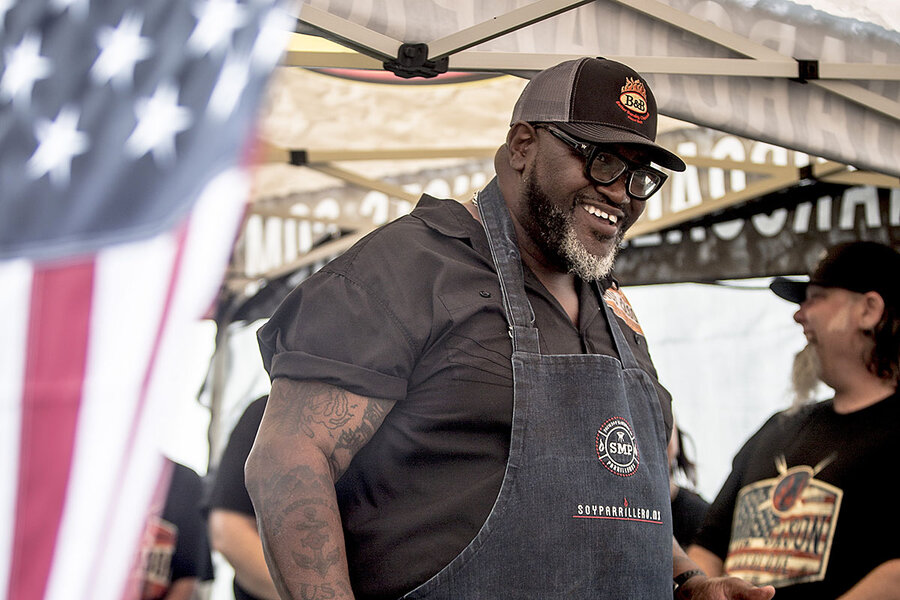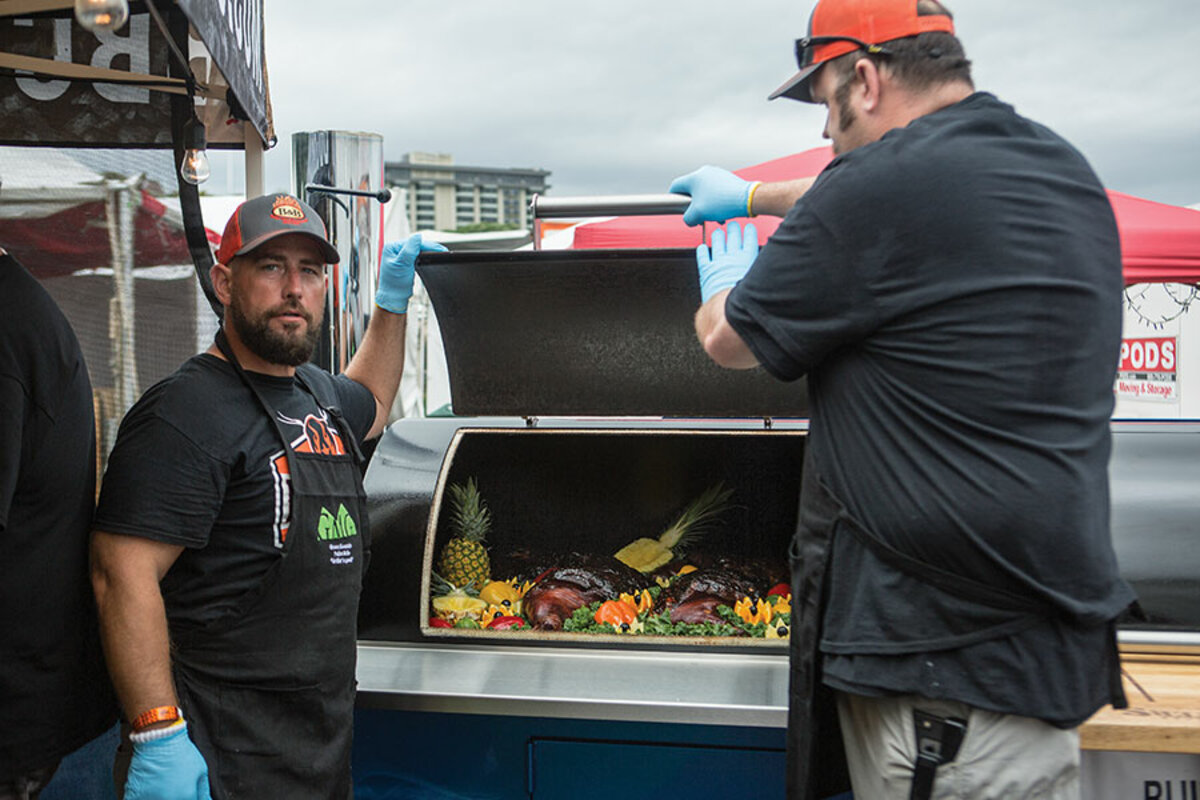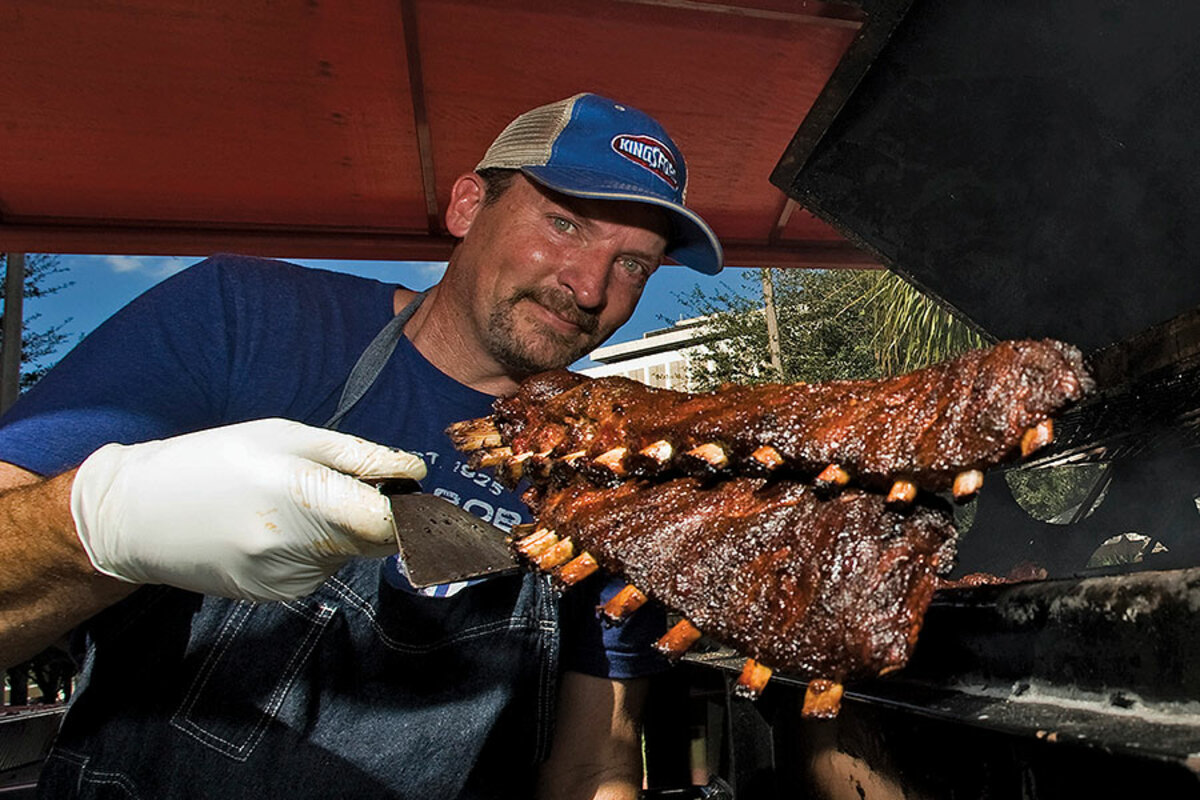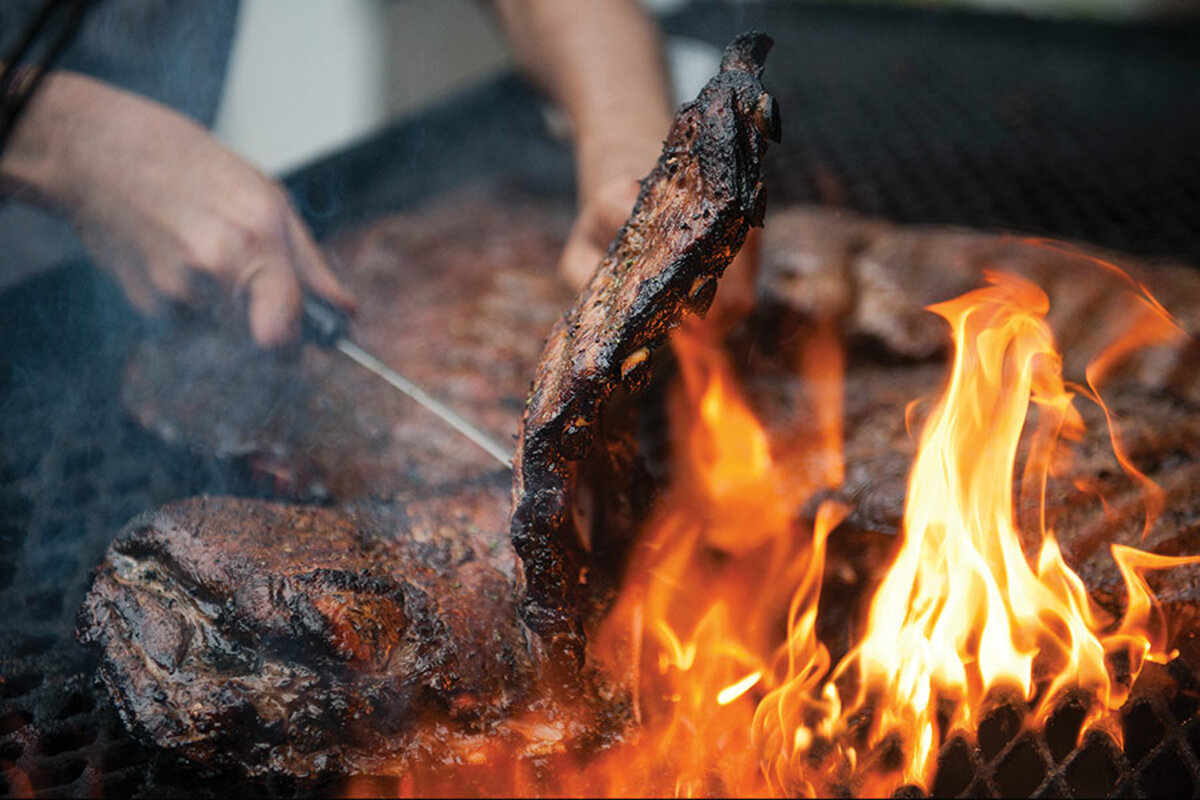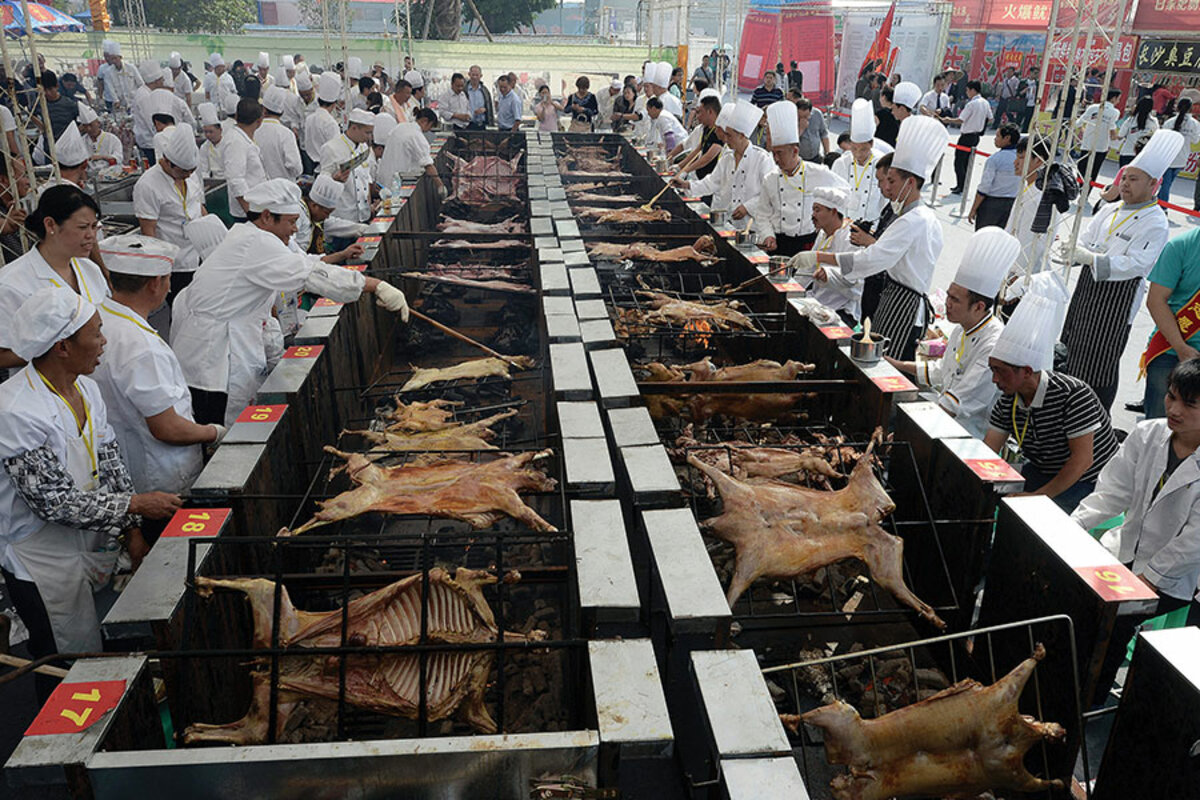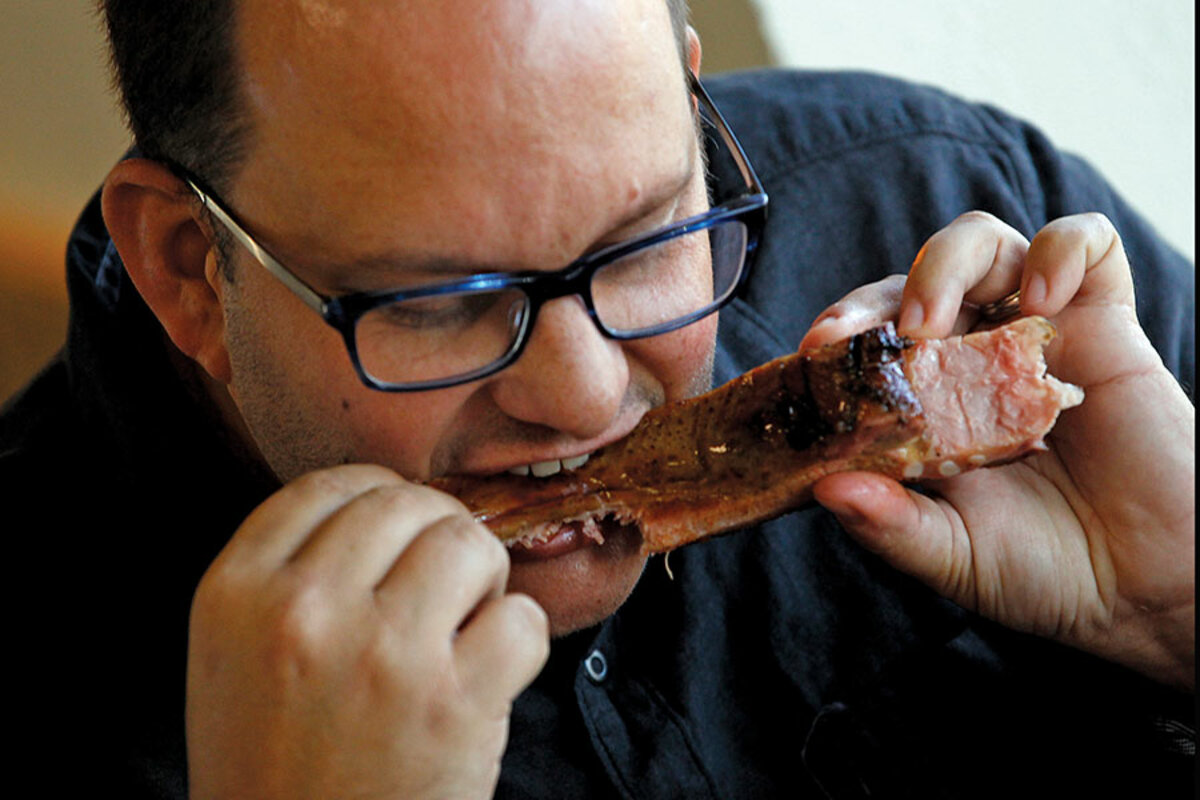Ambassadors of smoke
Loading...
| MEMPHIS, Tenn.
It’s a quiet morning on a crook in the Mississippi River, not too many miles from where Hernando de Soto feted members of the Chickasaw Indian tribe with the first American barbecue in 1540.
More than 200 white tents are spread out beneath a bluff, where some of the world’s best pitmasters have gathered to claim a piece of barbecue immortality – by smoking parts of a hog that they hope will win them recognition at the annual World Championship Barbecue Cooking Contest. A cool river breeze carries the scent of charred meat as the pitmasters open the lids of smokers to reveal glistening baby back ribs and pork butts.
Inside one tent, Marlando Cason quietly but intensely oversees a crew of 10, some of whom have been up all night cooking 200 pounds of pork shoulder. The pieces were cut from a special breed of pig, injected with a tamarind brine, and dusted with a fiery rub.
A Bunyan-size man in bib overalls, “Big Moe,” as he’s called, inspects the blackened piece of meat that has been smoking in a wood-fired cocoon for 12 hours. It has reached just the right internal temperature, 201 degrees F., that allows the pockets of fat to melt and percolate through the shoulder, producing a taste that the cooks hope will be transcendent for nine judges and maybe the competitors’ lives.
While Big Moe dotes on the pork, others on his team prepare the final ingredient – the barbecue sauce. They whisk together apple cider vinegar, red pepper jelly, and a concoction from a jar whose ingredients – like most pitmasters’ ingredients – are as secret as a CIA cable.
“Is it good?” asks one team member.
“It’s good,” says another.
“A little sweet,” worries a third who’s used to a tangier sauce.
As the Fourth of July weekend approaches, Americans across the country will be summoning their own inner pitmaster.
They may not be putting quite as much attention into their brisket and baby back ribs as Big Moe and his crew typically do. But thousands of Americans, nonetheless, moved beyond just flipping hamburgers and hot dogs a long time ago. They are now developing their own secret rubs, devising barbecue sauces out of beer and brown sugar, and firing up smokers that send their apple-wood aroma through neighborhoods.
What started out as a Southern phenomenon – “real” barbecue – has migrated across the country, becoming as hot as a hickory ember. It is evident in the rise of restaurants, backyard gatherings, professional competitions, new pit technology, and would-be Big Moes slathering pork with their own mop sauces.
Nor is the fascination limited to the United States. Southern-style barbecue is showing up in restaurants from China to finicky France. The only difference is that in Paris the main side dish isn’t beans or slaw. It is smoked cauliflower drizzled with chorizo vinaigrette.
“The barbecue renaissance is now global,” says John T. Edge, author of the just-released book “The Potlikker Papers: A Food History of the Modern South.”
That probably shouldn’t be surprising since barbecue is intertwined with the history, politics, and culture of the US as much as any other cooking style. It is to American food what jazz is to American music – a distinct art form with African-American roots that cuts across socioeconomic and demographic barriers, uniting more than dividing, but also maintaining regional differences.
Its current popularity stems in part from the mystique surrounding some of its impresarios, people like Big Moe, a water treatment plant operator who has risen to become something of a celebrity pitmaster. But even Big Moe knows that, with all the vagaries involved in smoking a piece of meat, there’s always a bit of mystery as to how it will come out. Which is why, as he gets ready to send the slices of pork shoulder off to be judged, all perfectly displayed in a plastic foam box, he addresses his crew with a mixture of confidence and hope.
“We’ve got this,” he says. “We’ve got this.”
Big Moe has a look that exudes barbecue cool. He stands more than 6 feet tall, with a frame that seems tailor-made for overalls – which he calls his “soft clothes” – and wears heavy gold jewelry.
He is drawn to barbecue for some of the same reasons a growing number of other people are: its authenticity and sense of tradition. Big Moe, who is African-American, says he’s the beneficiary of a long lineage that began in the South with African slaves creating barbecue from the scraps of their masters’ tables.
It started to move north in the early 1900s when a young black man, Henry Perry, brought the smoke-style of cooking from Memphis to the stockyards of Kansas City, Mo. From there, the largely African-American tradition spread farther to places such as Des Moines, Iowa, where Big Moe grew up.
“Barbecue is ... so popular, and it’s such a way of life, that it has no choice but to spread,” he says.
He might have added that it’s alluring because of its unpretentiousness and relative simplicity. True, there are the complex rubs, the physics of the fire pit, the different woods that perfume the meat with different flavors of smoke, the barbecue sauces that change with longitude as you move across the US – from the vinegary sauces of North Carolina to the sweet, tomato-based ones of Kansas City.
But at its core it is a primal process: a piece of meat cooked slowly in a smoker. Kevin Kuruc, a French-trained chef who is one of Big Moe’s competitors here, says barbecuing reflects a “simplicity that is its complexity.”
Yet despite all the set mechanics involved in cooking the meat, there’s an artistry to the process, too. Veteran pitmaster Jeff Spurgeon, a Big Moe team member who owns a Kansas City auto body shop and cooks in a “trash-can pit” with a painting of Johnny Cash on it, notes that “90 percent of the guys cooking barbecue use the exact same ingredients, yet no two plates ever taste alike. You just know whose food you’re eating. It’s an expression.”
In an age when fantasy football may surpass real football in popularity, barbecuing embodies an eat-with-your-hands realness. It’s what sends many people to the simple barbecue shacks that populate the South and increasingly the North. Customers from all backgrounds and ZIP Codes commune around benches with sticky tablecloths, watching a pitmaster labor next to a creosote-covered pit with cast-iron doors.
“That kind of knowledge and ability to coax tenderness and flavor out of a hunk of meat is in its own way a kind of mysterious art – that beneath billows of smoke and in close proximity to a fire, a cook, a pitmaster ... comes out with a perfectly roasted pork shoulder and rack of ribs,” says Mr. Edge, the author, who is also director of the Southern Foodways Alliance in Oxford, Miss., which studies the food culture of the region. “That mystery is compelling, and it’s one of the reasons we’re attached to barbecue.”
The other reason for barbecue’s current éclat may be a more artificial one – television. The proliferation of TV shows about cooking has propelled the foodie revolution in the US in general, but it has contributed to the mystique surrounding the art of smoking as well. Programs such as “BBQ Pitmasters,” in which a handful of cooks compete to create the best ribs or pulled pork, have helped make every weekend griller want to be a pitmaster and has turned real pitmasters into luminaries.
Big Moe knows the power of the lens. He won an audition to be a contestant on the show and figured it would be a one-off appearance. But his signature look, witty repartee, and penchant for handing out solid smoking tips have made him a popular frequent guest judge.
Soon he became a spokesman for Big Red soda and Little Caesars Pizza – catchphrase: “Certified smokified!” As he walks around the tent city here, people frequently come up and ask to take a selfie with him.
Over the next few months, he will travel overseas as a sort of ambassador of smoke. He has been invited to barbecue events in Sweden, Germany, and Australia. Representing barbecue – and America – “warms my heart,” he says.
The tour underlines the global fascination with smoked meat. Paris, for instance, now has at least two barbecue restaurants, The Beast and Flesh. Holy Smoke BBQ draws well-dressed foodies in Nyhamnsläge, Sweden. Mexico City; Vienna; Shanghai, China; and London all offer real American “cue.” In New Zealand and Australia, Meatstock, a music and barbecue festival, has become a huge annual event.
A few years ago, North Carolina expatriate David Straughan and Kansas City native Nick Jumara were living in China when they ended up in possession of a “sanwenche,” a kind of pedaled pickup, on which they mounted a smoker. They began serving pulled pork and other barbecue to people in the port city of Ningbo. While the two Americans couldn’t communicate what kind of food it was, the Chinese responded in a language that’s universal.
“There is a certain look of affirmation on someone’s face when they’re trying something new and decide that they like it,” writes Mr. Straughan of the experience in the “South Writ Large” blog.
Even though he grew up in Iowa, Big Moe learned about the culture of barbecue the way many Southerners do – from his grandmother. He was one of 17 grandchildren.
“As a young man, I was always intrigued with the grill, cooking on it, experimenting with it – nothing too crazy,” he says. “But that’s how I got introduced to it: My family was all about food.”
He didn’t know anything about barbecue competitions until 2006, when he heard a reference to one on a cable food network. “I was intrigued,” he says.
He took some money he’d put aside from his US Navy pay and bought a smoker. Soon he began competing at Kansas City Barbecue Society (KCBS) events. Within six years, he had earned $80,000 in winnings – serious money for a backyard cook but hardly riches. In a reflection of the realities of a pitmaster on the semipro circuit, he still works full time for the city of Des Moines in the treatment plant.
Still, there are no shortages of competitions for him to enter. KCBS events alone are expanding at a rate of about 25 percent per year. Two years ago, the organization added an international division to its competitions.
The World Championship Barbecue Cooking Contest in Memphis typifies the trend. What was once a down-home quirky affair – a Memphis culture critic recently mused about the time he saw a boy drag a barbecued raccoon through the mud – this year drew 236 teams from around the world, though that is down slightly from 2016. That includes the Norwegian National Barbecue Team, which counts among its members the king’s personal chef. Pitmasters compete in one of 10 categories – from best whole hog to best ribs to best exotics (think antelope).
Like many teams, Big Moe’s is a hybrid, with people from diverse backgrounds and locations – a reminder of the egalitarian nature of barbecue. He put out a call for recruits on Facebook and received hundreds of responses. Team member Dave Webb, of Dave’s Sticky Pig in Madisonville, Ky., remembers finding Big Moe’s tent, being introduced, and “promptly forgetting everyone’s name.”
While most had competed before, several were rookies, including Devon Rightsell, a factory worker from rural Missouri. “Yeah, he’s our oddball” as far as competition experience, says Big Moe. “But I just had a really good feeling about him.”
The man who tended the fire all night, “throwing sticks” in the smoker when needed, was Mike Jeffries from Wellington, New Zealand. A few years ago, he toured barbecue shacks across the American South for seven weeks (putting on a few pounds in the process), returned to New Zealand, and opened Big Smoke BBQ. Today he caters tony weddings and high-end corporate events.
Mr. Jeffries met Big Moe earlier this year in New Zealand, where the American was impressed with the Kiwi’s cylindrical fire pit. “I basically met Moe at Meatstock, and he invited me to come [to Memphis],” says Jeffries. “Let me tell you, I did not hesitate.”
While the high-end pits and star chefs down by the river represent the smoking culture’s global spread, Payne’s Bar-B-Q restaurant a few miles away on Lamar Avenue embodies what some worry are the fading roots of an American institution. The restaurant has resisted change, offering only pork – chopped or sliced – served with mustard slaw and beans flecked with more pork.
“This is what people come for, the atmosphere, the food. It needs to feel real,” says proprietor Candice Payne.
Ms. Payne still cooks with charcoal, but more and more old-school joints have abandoned wood for gas and adopted one-taste-fits-all commercialized menus. John Shelton Reed, a retired University of North Carolina sociologist, started The Campaign for Real Barbecue in 2015 to certify wood-fired restaurants. To be sure, he says, the growing popularity of barbecue is helping it evolve in good ways, too, fusing traditional techniques, for instance, with a Millennial penchant for authentic hands-on cooking and farm-to-table sourcing.
“But what’s going away [in some places] is that a lot of Southern old-timey family barbecue places – the kind of place where a whole community goes – have switched to gas entirely,” says Mr. Reed. “[Fiercely regional cuisines have] been replaced with what I call the ‘International House of Barbecue’ model, where the customer is always right, which is not how it’s been traditionally. It’s like in Kansas City, you need sauce and it needs to be thick, red, sweet, with a little bit of heat – in other words, ketchup with stuff in it. It’s the threat of uniformity which I find annoying.”
Craig Whitson, who grew up in Oklahoma but has lived in Norway for more than 30 years, concurs. “The ‘real barbecue’ thing has all happened in the last 10 years,” says the pitmaster for the Norwegian national team, who speaks English with a Scandinavian accent. “Barbecue has got this sort of coolness factor, which I would hate to see it lose. If it got too big, perhaps it would fall to the wayside.”
Concern swirls, too, that barbecuing is shedding its African-American roots. The competition circuit, in particular, is now virtually all white. Many black pitmasters pulled out because the events started to feel like they were too much about money and big sponsors and too little about good pork. Big Moe is at times a lonely torchbearer.
While he understands that any exclusion of black pitmasters is inadvertent, “I am still a bit shocked” by the optics, he says. On his original TV audition tape, he says he told the producers: “You need to mix it up. You ain’t got no color up there.”
The danger is that it can seem like a “white middle-class takeover of black craft and expertise,” says Edge of the Southern Foodways Alliance. That is “something to reckon with.”
Barbecuing, of course, has always been bound up in the politics and race of the nation. Six years before colonists dumped tea in Boston Harbor to protest British tariffs, the royalist governor of North Carolina, William Tryon, tried to appease local militiamen by roasting a whole ox. The men responded by tossing the roast in the river, an act of affirmed loyalties hence referred to as the Wilmington Barbecue.
Later, slaves such as Gabriel Prosser and Nat Turner planned their anti-slavery rebellions at barbecues.
During the Jim Crow years, barbecue joints became emblematic of the segregationist South, as racially distinct as lunch counters. After the passage of the Civil Rights Act in 1964, the Supreme Court ordered Ollie’s Barbecue in Birmingham, Ala., to serve black customers. Owner Ollie McClung had argued that his business wasn’t involved in interstate commerce, so the federal courts, under the Commerce Clause, had no jurisdiction over it. All nine justices disagreed, noting that nearly half of the meat Mr. McClung smoked came from out of state. And it wasn’t until 2014 that the late Maurice Bessinger’s Piggie Park barbecue empire in South Carolina took down Confederate regalia, which was put up in 2000 to protest efforts to remove the Confederate flag from the State House in Columbia.
Even though he is proud of barbecue’s black traditions, Big Moe’s focus at the moment isn’t on civil rights. It’s on civil flavors.
The pork shoulder has come out of the smoker after cooking all night. The team has chosen the tenderest bits of meat, soaked them with pan juice, and applied a glaze of barbecue sauce. The slices glisten in the plastic foam box.
Now it’s a matter of getting the meat to the judges while it’s still warm and by the deadline. Two team members thread their way through the menagerie of tents – one acting as carrier, the other as “blocker” – and deliver the precious cargo.
“We did everything right,” Big Moe tells the team. “I’d be surprised if we don’t walk the stage.”
Most of the cooks scatter to shower and rest before the awards ceremony. Later, a contest official comes by to suggest the team “should definitely” attend the ceremony – a not-so-subtle hint of something to come.
That night, Big Moe’s team takes fifth out of 55 competitors, bested only by a few legendary pitmasters. Big Moe’s cooks walk the stage to raucous cheers. For Mr. Rightsell, the Missouri factory worker, the moment is “life-changing.” He has already started construction on his own pit at home. For Mr. Spurgeon, the body shop owner, creating a championship team out of a group of strangers in three short days is affirmation of barbecue’s ability to not just feed people, but forge relationships.
Big Moe is more expansive. He points out that though Southern slaves were the first legendary pitmasters, there would be no American cuisine without the Spanish, who brought the pigs; the Germans, who brought the mustard; and the French, who supplied the vinegar.
In the end, he says simply, “it’s about keeping true to who you are through a process of cooking.”




